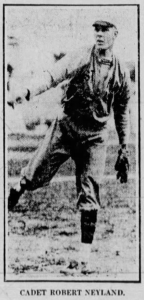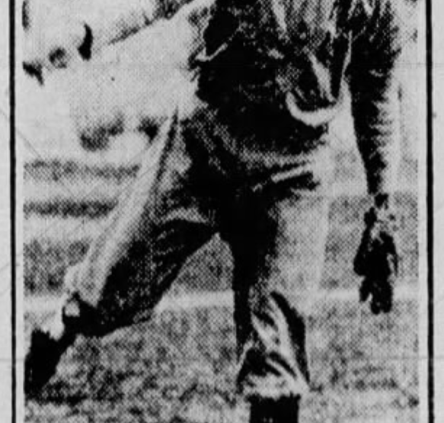May 30, 1914: Robert Neyland hurls three-hitter as Army defeats Navy for sixth year in a row
 The Army-Navy game of 1914 was played on Memorial Day, Saturday, May 30, at the US Naval Academy in Annapolis, Maryland. This was the final game of the season for both teams and the 13th annual meeting of the rival service academies.1
The Army-Navy game of 1914 was played on Memorial Day, Saturday, May 30, at the US Naval Academy in Annapolis, Maryland. This was the final game of the season for both teams and the 13th annual meeting of the rival service academies.1
At practice the day before, Army coach Sammy Strang discovered something wrong with the diamond at Worden Field, the site of the game. Using a tape measure, he determined that the distance from the pitcher’s rubber to home plate was only 56 feet 8 inches, instead of the regulation 60 feet 6 inches.
When alerted to the problem, the Navy coaches said, “We must have been 3 feet 10 inches short all season, through error.” They asked Strang if they could “split the distance” and claimed, “If we move it back 3 feet 10 inches, the Navy pitchers will not have a chance because their control will be away off.” “I am doing this by the book,” replied Strang, “and I insist that the distance be [fully] corrected.”2
Strang was not fooling around. He was a former major leaguer who had played for the New York Giants under John McGraw. His playing days behind him, Strang was a successful coach in his sixth season at the US Military Academy at West Point, New York. His Army teams had defeated Navy five years in a row. In 1914 he was looking to make it six straight.
The Navy team came into the game with a season record of 11 wins and 7 losses. The Army squad, having played fewer games due to inclement weather, held an 8-5 mark.3 (One of the Army losses, at West Point on May 8, was to a group of second-string New York Giants that included Jim Thorpe.4 McGraw had sent them as a favor to Strang.)
Now, in the biggest game of the season, the Navy batters would face a formidable ace, Army pitcher Robert Reese Neyland III, a 6-foot, 175-pound sophomore from Greenville, Texas.5 Neyland (pronounced “KNEE-lund”) had won his last 10 games, including a 2-1 victory over Navy as a freshman in 1913 and a no-hitter against Colgate on April 11, 1914.6 His batterymate was Frank “Shrimp” Milburn, the sole senior in the Army lineup.
Navy countered with its ace, Thomas “Swede” Vinson. He was the only senior in the Navy lineup and considered “the star of the Navy aggregation.”7 Walter “Spuds” Hicks was the Navy catcher and team captain. Lieutenant Robert A. Theobald was the Navy head coach, and Jim Reilly, a former Yale star, served as an assistant coach.8
The assembled crowd of 12,000 was “the largest that ever attended an athletic event in Annapolis.”9 The lively atmosphere was enhanced by the Navy bugle and drum corps. The Navy goat, “official mascot, bedecked in [a] blanket of gold and blue cloth … trotted around the diamond prior to the game.”10
At West Point, hundreds of cadets gathered in the gym, “where a direct wire with Annapolis and an automatic scoreboard” would report the play-by-play.11 It is likely that one of those cadets was Dwight “Ike” Eisenhower, a junior from Abilene, Kansas. With National League umpires Harry “Steamboat” Johnson behind home plate and Fred Lincoln on the bases, the game commenced at 2:30 P.M.
Charles Gerhardt, the sole freshman in the Army lineup, led off and drew a base on balls from Vinson. Leland Hobbs followed with a single, a Texas Leaguer that fell into short left field. Neyland advanced the runners with a sacrifice. Vinson walked Louis Merillat, loading the bases for Bill Coffin, a sophomore from Greensboro, North Carolina. Coffin sent a liner into center field that bounded over the head of center fielder Hilbert “Bud” Fisher. Three men scored and Coffin was credited with a triple, giving the Cadets a 3-0 lead. Vinson struck out the next two batters.
Navy scored a run against Neyland in the first inning and another in the second, and both runs were obtained without getting a hit. Two walks, a stolen base, and a fly ball brought in the first run, and a hit batsman and two errors accounted for the second run.
In between, however, Hobbs hit a two-run homer in the Army half of the second. Army added a run without a hit in the fifth: Coffin drew a walk and came around to score after a wild pitch and error. The Cadets led, 6-2.
Rain came down in the sixth inning but the game continued. With two outs, Gerhardt singled and stole second base. Hobbs drove him in with a single. The next inning, Merillat singled and was brought home by Milburn’s single.
Meanwhile, Neyland stymied the Navy offense. Navy’s Ranney Adams singled in the third inning but did not score. When Bud Fisher singled in the eighth inning, it was only the second hit allowed by Neyland. Fisher advanced to second base on an infield out and was thrown out by Milburn while attempting to steal third. Hicks’s ninth-inning single was Navy’s third and final hit of the game.
It was a decisive rout. The final score was Army 8, Navy 2. Army had defeated Navy for the sixth year in a row, and Neyland earned his 11th consecutive victory. Army collected 12 hits, with every player getting at least one; Hobbs had three hits and Omar Bradley had two. The fielding was ragged on both sides: Army was charged with six errors and Navy committed five.
It is unknown whether the relocation of the pitching rubber affected Vinson’s pitching. He walked three batters and threw two wild pitches in nine innings pitched.12
Epilogue
Robert Neyland continued his winning streak, extending it to 20 games before losing to Fordham on May 15, 1915. He defeated Navy twice more, on May 29, 1915, and May 27, 1916. In four seasons of pitching for Army, his career record was 35 wins and 5 losses. After graduation, he chose not to become a professional baseball player and reportedly turned down a lucrative offer from John McGraw and the Giants.
Instead, Neyland pursued dual careers, serving in the Army Corps of Engineers and coaching the football team at the University of Tennessee. In 21 seasons as the Tennessee head coach, his teams won 173 games, lost 31, and tied 12. His 1951 team won the Associated Press national championship. In 1956 he was inducted into the College Football Hall of Fame. Neyland Stadium in Knoxville is named for him.
During World War II, Neyland rose to the rank of brigadier general (one-star general). Working in China and India, he led efforts to supply food, medicine, fuel, and ammunition to American, British, and Chinese troops.
Charles Gerhardt (Army third baseman) and Leland Hobbs (Army right fielder) were major generals (two-star) in the war and each commanded an infantry division that landed at Omaha Beach. Gerhardt’s division landed there on D-Day. Frank Milburn (Army catcher) also was a major general during the war; he was promoted to lieutenant general (three-star) in the Korean War.
General Omar Bradley (Army left fielder) led more than 1.2 million troops into combat in World War II. In 1950 he was promoted to the highest rank, five-star General of the Army. Vice Admiral Bertram Rodgers (Navy right fielder) was a commanding officer of naval operations at the Aleutian Islands (1943), Southern France (1944), and Iwo Jima (1945).
Acknowledgments
The author thanks Adam Minakowski, assistant archivist, Nimitz Library, U.S. Naval Academy.
This game was fact-checked by Kevin Larkin and copy edited by Len Levin.
Sources
Army’s Howitzer and Navy’s Lucky Bag yearbooks, 1914-1917. The 1915 Howitzer contains an account of the 1914 Army-Navy baseball game.
Gilbert, Bob. Neyland: The Gridiron General (Savannah, Georgia: Golden Coast Publishing Co., 1990).
Hall of Valor: The Military Medals Database, at valor.militarytimes.com, accessed April 2023.
Haskew, Michael E. West Point 1915: Eisenhower, Bradley, and the Class the Stars Fell On (Minneapolis: Zenith Press, 2014).
Photo credit: Minneapolis Journal, June 8, 1915: 14.
Notes
1 “Army Meets Navy Today,” Baltimore Sun, May 30, 1914: 7. Army had defeated Navy in nine of the 12 previous games. The series began in 1901. There was no game in 1903.
2 Bob Wilson, “Sport Talk,” Knoxville (Tennessee) News-Sentinel, April 2, 1952: 17.
3 “Army Meets Navy Today”; “Army Defeats Penn State,” Pittsburgh Gazette Times, May 7, 1914: 11.
4 “Giants’ Subs Win,” Philadelphia Inquirer, May 10, 1914: Sports, 3. The Giants won, 7-2. Jim Thorpe hit a tape-measure home run in the contest.
5 “Nine at West Point Possesses Remarkable Hurler in Neyland,” North Adams (Massachusetts) Transcript, May 14, 1915: 11.
6 “Army 8, Colgate 0,” Boston Globe, April 12, 1914: 18,
7 “Georgetown Wins from the Middies,” Baltimore Sun, May 24, 1914: 15.
8 “Middies Win Opener,” Baltimore Sun, March 26, 1914: 5.
9 “12,000 See Army Win Service Game,” Baltimore Sun, May 31, 1914: 13.
10 “12,000 See Army Win Service Game.”
11 “Cadets Watch Scoreboard,” Washington Evening Star, May 31, 1914: 1.
12 “12,000 See Army Win Service Game.”
Additional Stats
Army 8
Navy 2
Worden Field
Annapolis, MD
Corrections? Additions?
If you can help us improve this game story, contact us.


